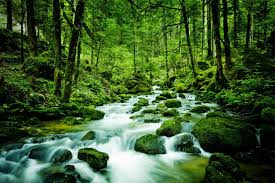TYPES OF THE ECOSYSTEM
Ecosystem
- An ecosystem is the ecological system or a community of living and nonliving components where both these components of the environment interact with each other.
- Therefore, Ecosystem consists of two components called Biotic components (living factors) and A-biotic components (Non-living factors).
- These two components form the basic structure of an ecosystem and are linked together through nutrient cycles and energy flows.
A-Biotic Components
- Inorganic Nutrients, e.g. water, elements (N,P,K etc.) and gases like CO2,O2,N2 etc.
- Organic Compounds- carbohydrates, protein, lipids etc.
- Climatic factors- temperature, light, rainfall, humidity etc.
Biotic Components
- Plants
- Animals
- Microorganism
Biotic components may be either autotrophs or heterotrophs based on their nutritional characteristics.
TYPES OF ECOSYSTEM
The ecosystem may be of temporary nature (pond, crop land) or of permanent nature (e.g. ocean). Though the ecosystems are simply separated from each other but, functionally they are linked together.
Broadly ecosystem can be divided into two types.
- Natural Ecosystem- It includes Terrestrial ecosystem & Aquatic ecosystem.
- Artificial Ecosystem- These are man made ecosystem, e.g. pond, cropland, garden, well etc.
Terrestrial Ecosystem
Terrestrial ecosystems mean land-based ecosystems. There are different types of terrestrial ecosystems distributed around various geological zones.
- Forest Ecosystem– There is many different types of forests all over the world for example, tropical rainforest, and tropical deciduous, temperate deciduous, conifers etc. In forest system larger weight of producer support a smaller weight of consumers.

- Grassland Ecosystem- In a grassland ecosystem, the vegetation is dominated by grasses and herbs, e.g. pampas, prairies and savanna grassland etc. where larger weight of producer supports a smaller weight of consumers.
- Desert Ecosystem- These are regions with scanty rainfall and characterized by normally hot day and cold night. Examples are Thar (Rajasthan), Sahara (North Africa), Kalahari (South Africa) etc.
- Tundra– Tundra ecosystems are devoid of trees, scanty rainfall and are found in cold climate. These are covered with snow for most of the year. Hence limited amount of life can be supported in these harsh conditions.
- Polar
Aquatic Ecosystem
Aquatic ecosystems mean water-based ecosystems. Aquatic ecosystem can be further divided into –

- Marine Ecosystem- it includes ocean and sea, estuarine (zone between sea & continent), sunder ban etc. Such ecosystem has greater biodiversity than freshwater ecosystems. Ocean and sea contain huge salt content.
- Freshwater Ecosystem– fresh water may be lentic (standing freshwater, e.g. lake, pond etc.) or lotic (running fresh water, e.g. river, spring).
Read more..
WHAT BIODIVERSITY IS-MEANING,TYPES&THREATS
IMPORTANCE OF BIODIVERSITY
BIODIVERSITY HOTSPOTS IN INDIA
WHAT IS WEEDS-CHARACTERISTIC, CLASSIFICATION & CONTROL
NITROGEN FIXATION-DEFINITION, PROCESS& TYPES
WATER HARVESTING-DEFINITION,TYPES & ADVANTAGES
WHAT IS PROCESS OF COMMUNICATION